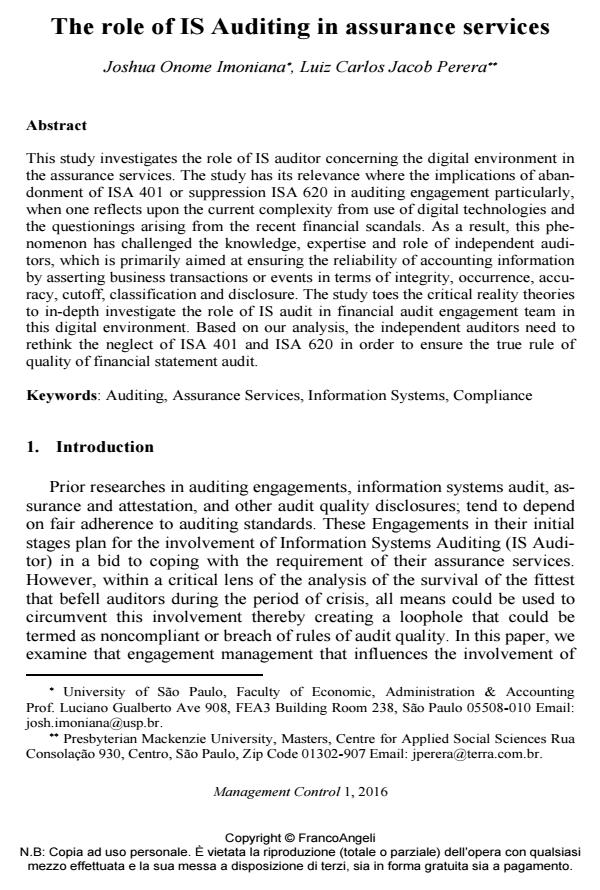The role of IS Auditing in assurance services
Titolo Rivista MANAGEMENT CONTROL
Autori/Curatori Joshua Onome Imoniana, Luiz Carlos Jacob Perera
Anno di pubblicazione 2016 Fascicolo 2016/1 Lingua Inglese
Numero pagine 17 P. 17-33 Dimensione file 81 KB
DOI 10.3280/MACO2016-001002
Il DOI è il codice a barre della proprietà intellettuale: per saperne di più
clicca qui
Qui sotto puoi vedere in anteprima la prima pagina di questo articolo.
Se questo articolo ti interessa, lo puoi acquistare (e scaricare in formato pdf) seguendo le facili indicazioni per acquistare il download credit. Acquista Download Credits per scaricare questo Articolo in formato PDF

FrancoAngeli è membro della Publishers International Linking Association, Inc (PILA)associazione indipendente e non profit per facilitare (attraverso i servizi tecnologici implementati da CrossRef.org) l’accesso degli studiosi ai contenuti digitali nelle pubblicazioni professionali e scientifiche
This study investigates the role of IS auditor concerning the digital environment in the assurance services. The study has its relevance where the implications of abandonment of ISA 401 or suppression ISA 620 in auditing engagement particularly, when one reflects upon the current complexity from use of digital technologies and the questionings arising from the recent financial scandals. As a result, this phenomenon has challenged the knowledge, expertise and role of independent auditors, which is primarily aimed at ensuring the reliability of accounting information by asserting business transactions or events in terms of integrity, occurrence, accuracy, cutoff, classification and disclosure. The study toes the critical reality theories to in-depth investigate the role of IS audit in financial audit engagement team in this digital environment. Based on our analysis, the independent auditors need to rethink the neglect of ISA 401 and ISA 620 in order to ensure the true rule of quality of financial statement audit.
Keywords:Auditing, Assurance Services, Information Systems, Compliance
- Allegrini M., D’Onza G. (2011), Corporate governance, risk management e responsabilità sociale fra presente e futuro dell’attività di internal auditing, Management Control, 1, pp. 151-178. DOI: 10.3280/MACO2015-001007
- Alles M., Tostes F., Vasarhelyi M.A., Riccio E.L. (2006), Continuous auditing: the USA experience and considerations for its implementation in Brazil, Journal of Information Systems and Technology Management, 3(2), pp. 211-224. DOI: 10.4301/S1807-17752006000200007
- Bierstaker J., Abbott L., Caster P., Parker S., Reckers P. (2001), Comments by the Auditing Standards Committee of the Auditing Section of the AAA on the Proposed International Standards on Auditing Revisions to ISA 315 and ISA 610, Current Issues in Accounting, 5(1), pp. 8-10.
- Burrell G., Morgan G. (1979), Sociological paradigms and organizational analysis: Elements of Sociology of corporate life, London, Heinemann, 1979.
- Cohen J.R., Simnett R. (2015), CSR and Assurance services: A research agenda, Auditing, A Journal of Practice & Theory 34(1), pp. 59-74. DOI: 10.2308/ajpt-50876
- DiMaggio P.J., Powell W. (1983), “THE IRON CAGE REVISITED”: Institutional isomorphism and collective rationality in organizational fields, American Sociological Review, 48(2), pp. 147-160.
- Francese R., Passero I., Zarraonandia T. (2012), An Augmented Reality Application to Gather Participant Feedback During a Meeting. In: Marco De Marco, Dov Teéni, Valentina Albano & Stefano Za (Org.) Information Systems: Crossroads for Organization, Management, Accounting and Engineering, ItAIS, Rome, Physica-Verlag Springer.
- Imoniana J.O. (2008), Auditoria de Sistemas de Informação (Information Systems Auditing), 2nd ed., São Paulo, Atlas.
- Imoniana J.O., Silva R.M. (2013), Revisiting the concepts of forensic accounting and corporate fraud, Int. J. of Auditing Technology, 1 (2), pp. 78-86.
- Ippolito M. (2012), Il Modello Organizzativo ex d.lgs. 231/2001 e la Sarbanes-Oxley statunitense, La responsabilità amministrativa delle società e degli enti, Rivista 231, No. 2. 2012.
- Laclau E. and Mouffe C. (2001), Hegemony and socialist strategy, 2nd Edition, London, Verso.
- Laudon K, Laudon J. (2007), Essentials of management information systems, São Paulo, Pearson Prentice Hall.
- Lindig C., Snelting G. (1997), Assessing modular structure of legacy code based on mathematical concept analysis, Proceedings of the 19th International Conference on Software Engineering, 17-23 May, pp. 349-359. DOI: 10.1145/253228.253354
- Murcia Fernando Dal-Rui, BORBA José Alonso, Schiehll Eduardo (2008), Relevância dos red flags na avaliação do risco de fraudes nas demonstrações contábeis: a percepção de auditores independentes brasileiros, Revista Universo Contábil, Blumeanau, 4(1), pp. 25-45.
- Namuduri K. (2013), Information systems auditing – going beyond compliance, Int J. of Auditing Technology, 1(1), pp. 45-51. DOI: 10.1504/IJAUDIT.2013.052247
- Obaidat Ahmad N. (2007), Auditors compliance with International Standards on Auditing: Evidence from Jordan, J. of Social Sciences 3(4), pp. 185-189. DOI: 10.3844/jssp.2007.185.189
- Oprosko Joe (2010), The Importance of Financial Controls. Disponível em: <http://www.theiia.org/intAuditor/in-the-industry/2010/gaming/the-importance-of-financial-controls/>. Acesso em 19 de maio de 2013.
- Paulhus D.L., Williams K.M. (2002), The dark trait of personality: narcissism, Machiavellianism, and psychopathy, J. of Research in Personality, 36, pp. 556-563.
- Raitoharju R., Laine M. (2006), Exploring the differences in information technology acceptance between healthcare professionals, Proceedings of the 12th American Conference on information Systems, 4-6 August, Acapulco, Mexico, pp.2644-2651.
- Seeburn K. (2013), The IS auditor: what are the key knowledge requirements, Intl J. of Auditing Technology, 1(1), pp. 34-44. DOI: 10.1504/IJAUDIT.2013.052244
- Shafer W.E, Wang Z. (2011), Effects of ethical context and Machiavellianism on attitudes toward earnings management in China, Managerial Auditing Journal, 26(5), pp. 372-392. DOI: 10.1108/02686901111129553
- Vasarhelyi M.A., Alles M., Kogan A. (2004), Principles of analytic monitoring for continuous assurance, Journal of Emerging Technologies in Accounting, 1(1), pp. 1-21.
- Whitten J.L., Bentley L.D., Dittman K.C. (2001), Systems Analysis and Design Methods, 5th ed., New York, McCraw-Hill Higher Education.
Joshua Onome Imoniana, Luiz Carlos Jacob Perera, The role of IS Auditing in assurance services in "MANAGEMENT CONTROL" 1/2016, pp 17-33, DOI: 10.3280/MACO2016-001002